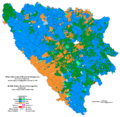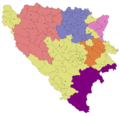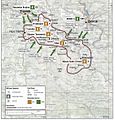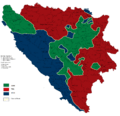Bosnian War facts for kids
Quick facts for kids Bosnian War |
||||||||
|---|---|---|---|---|---|---|---|---|
| Part of the Yugoslav Wars | ||||||||
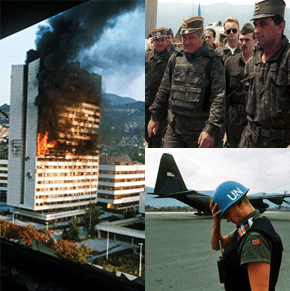 The Executive Council Building burns after being hit by tank fire in Sarajevo May 1992; Ratko Mladić with Army of Republika Srpska officers; a Norwegian UN soldier in Sarajevo. |
||||||||
|
||||||||
| Belligerents | ||||||||
|
1992: |
1992: |
|||||||
|
1992–94: |
1992–94: |
1992–94: Supported by: |
||||||
|
1994–95: |
1994–95: Supported by: |
|||||||
| Commanders and leaders | ||||||||
|
…and others |
(HVO Chief of Staff) …and others |
|
||||||
| Strength | ||||||||
| ARBiH: 110,000 troops 100,000 reserves 40 tanks 30 APCs |
HVO: 45,000–50,000 troops 75 tanks 50 APCs 200 artillery pieces HV: 15,000 troops |
VRS: 80,000 troops 300 tanks 700 APCs 800 artillery pieces AP Western Bosnia: 4,000–5,000 troops |
||||||
| Casualties and losses | ||||||||
| 30,521 soldiers killed 31,583 civilians killed |
6,000 soldiers killed 2,484 civilians killed |
21,173 soldiers killed 4,179 civilians killed |
||||||
| additional 5,100 killed whose ethnicity and status are unstated | ||||||||
|
a b |
||||||||
The Bosnian War was a serious conflict in Bosnia and Herzegovina that lasted from April 6, 1992, to December 14, 1995. It was part of the larger Yugoslav Wars. This war involved different groups from Bosnia and Herzegovina, Serbia and Montenegro, and Croatia. Sometimes, people call it "The aggression on Bosnia and Herzegovina" or "Civil War in Bosnia and Herzegovina."
During the nearly four-year war, it's thought that around 94,000 people lost their lives. Also, about 1.8 million people had to leave their homes. The war happened because of many problems in the country after the Cold War ended and the socialist system in Yugoslavia broke down. The fighting stopped when a Peace Agreement was signed in Dayton, Ohio, on November 21, 1995.
Contents
What Caused the Bosnian War?
The Bosnian War began because of many complex reasons. After the Cold War ended, the country of Yugoslavia started to break apart. Different parts of Yugoslavia, like Slovenia and Croatia, declared their independence. This created a lot of tension and disagreements.
When Bosnia and Herzegovina also decided to become an independent country, some groups within it did not agree. This led to fighting as different communities tried to control land and power. The war was a sad result of these deep political and social problems.
Who Were the Main Groups Fighting?
In the Bosnian War, several main groups were involved in the fighting. These groups were made up of different ethnic communities living in Bosnia and Herzegovina, along with support from neighboring countries.
Forces of Bosnia and Herzegovina
- The main force was the Army of the Republic of Bosnia and Herzegovina (ARBiH). This army was made up mostly of Bosniaks, who are the largest ethnic group in Bosnia. They fought to keep Bosnia and Herzegovina as a single, independent country.
- They had about 110,000 soldiers and 100,000 reserve troops. They also had some tanks and armored vehicles.
Croatian Forces
- The Croatian Defence Council (HVO) was the main military force of the Croats of Bosnia and Herzegovina. They aimed to protect Croat areas within Bosnia.
- The Croatian Army (HV) from neighboring Croatia also joined the fighting to support the HVO.
- Together, these forces had around 45,000 to 50,000 HVO troops and 15,000 HV troops. They had more tanks and artillery than the Bosnian army.
Serbian Forces
- The Army of Republika Srpska (VRS) was the main military force of the Serbs of Bosnia and Herzegovina. They fought to create a separate Serbian state within Bosnia or to join with Serbia.
- They were supported by the Yugoslav Army (VJ) from FR Yugoslavia (which included Serbia and Montenegro).
- The VRS was a very strong force, with about 80,000 soldiers, many tanks, and a lot of artillery.
- A smaller group called the Autonomous Province of Western Bosnia also fought alongside the Serbian forces later in the war.
How the War Ended
The Bosnian War officially ended on December 14, 1995, with the signing of the Dayton Agreement. This peace agreement was a very important step. It was signed in Paris by the leaders of Bosnia and Herzegovina, Croatia, and Serbia.
The agreement created a new political structure for Bosnia and Herzegovina. It divided the country into two main parts: the Federation of Bosnia and Herzegovina and the Republika Srpska. It also set up international forces, like NATO troops, to help keep the peace and make sure the agreement was followed. The Dayton Agreement helped bring an end to the terrible fighting and allowed people to start rebuilding their lives.
Images for kids
-
Aerial photograph of destroyed buildings in Mostar
-
Bosnia and Herzegovina before the Dayton Agreement
-
Seated from left to right: Slobodan Milošević, Alija Izetbegović and Franjo Tuđman signing the final peace agreement in Paris on 14 December 1995.
-
A grave digger at a cemetery in Sarajevo, 1992
See also
 In Spanish: Guerra de Bosnia para niños
In Spanish: Guerra de Bosnia para niños


